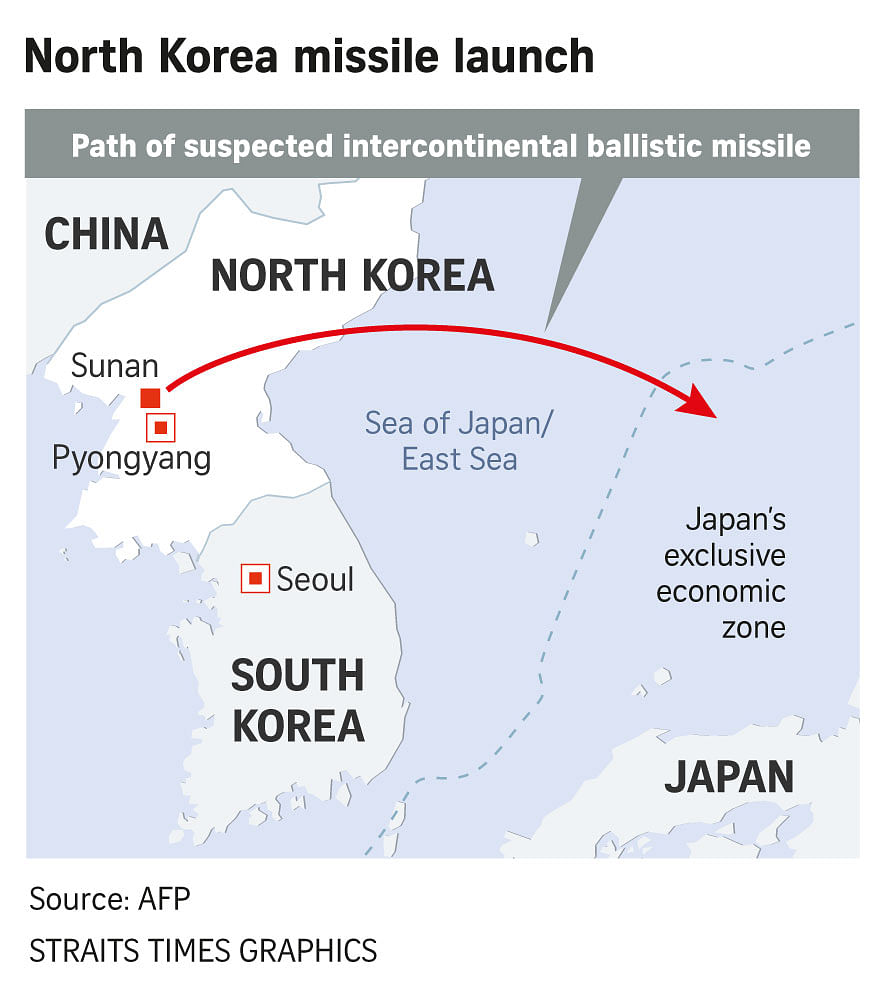North Korea fires suspected intercontinental ballistic missile into Japan’s exclusive economic zone
Sign up now: Get insights on Asia's fast-moving developments

A North Korean "new type" ICBM being launched, in an undated photo released by North Korea's state media on March 24, 2022.
PHOTO: REUTERS
Follow topic:
SEOUL - North Korea has launched what could be its first inter-continental ballistic missile (ICBM) since November 2017, breaking a self-imposed moratorium and drawing stern reaction from the United States and its allies.
The missile, which marks Pyongyang’s 12th show of force this year, was detected on Thursday (March 24) afternoon by both South Korea and Japan.
South Korea’s Joint Chiefs of Staff (JCS) said the missile, likely ICBM, was launched from Pyongyang’s Sunan airfield at 2.34pm (Korea time) and flew about 1,080km towards the east, reaching an altitude of over 6,200km.
Japan said the missile seems to be a “new type” of ICBM capable of reaching the US east coast. It flew for about 1,100km over 71 minutes to land inside Japan’s exclusive economic zone off the northern Aomori prefecture.
Japanese Prime Minister Fumio Kishida denounced the test as an “unforgivable outrage”.
“These series of actions taken by North Korea threaten the peace and security of our country, the region and the international community, and they are absolutely unacceptable,” he said in Brussels, where he is set to meet other world leaders on the Ukraine crisis.
South Korean President Moon Jae-in called the launch a “clear violation” of United Nations Security Council resolutions that “causes a serious threat to the Korean peninsula and beyond”.
Speaking at an emergency national security meeting, he urged Pyongyang to stop raising tensions and return to the dialogue table.
The JCS has also voiced disapproval and in response, fired missiles from the ground, sea and air towards waters in the east coast, in a show of force against the North.
South Korea’s military has the ability and posture to “precisely strike the origin of (North Korea’s) missile launch... at any time”, the JCS said.
The US State Department said the launch “demonstrates the threat the DPRK’s unlawful weapons of mass destruction and ballistic missile programmes pose”.
DPRK, or Democratic People’s Republic of Korea, is North Korea’s official name.
“We stand with the international community to call on the DPRK to refrain from further provocations and engage in sustained and substantive dialogue,” said spokesman Ned Price.
“Our commitment to the defence of (South) Korea and Japan remains ironclad. We have been and will continue to coordinate closely with our allies and partners to address the threats posed by the DPRK, and to advance our shared objective of the complete denuclearisation of the Korean Peninsula.”
White House press secretary Jen Psaki said the launch “needlessly raises tensions and risks destabilising the security situation in the region”.
“The door has not closed on diplomacy, but Pyongyang must immediately cease its destabilising actions,” she said in a statement.
Dialogue between North Korea and the US has stalled since the 2019 summit between North Korean leader Kim Jong Un and former US president Donald Trump broke down due to differences over sanctions relief and denuclearisation actions.
Both sides left the option to return to dialogue open. But since January, Pyongyang has accelerated its pace of missile testing and hinted it will restart “all temporarily suspended activities”, referring to its 2018 moratorium on testing ICBM and nuclear weapons.
North Korea’s return to ICBM testing poses a new security risk at a time when the world is seeking solutions to Russia’s invasion of Ukraine, and just before South Korean leadership switches from the dovish Mr Moon to a more hawkish conservative administration.
Dr Cheong Seong-chang of the Sejong Institute think-tank said North Korea has been expected to launch an ICBM as “cannon” to mark the late founder Kim Il Sung’s 110th birthday on April 15.
“Since the US-Russia relationship is currently at its worst, North Korea deems that Russia will not cooperate if the US attempts to adopt super-strong sanctions against the North for firing an ICBM or conducting a nuclear test,” he said.
Dr Cheong said Thursday's missile is likely the new Hwasong-17 that was unveiled at a military parade in October 2020 but not tested yet. He added that the missile can fly an estimated 15,000km with a warhead weighing less than one tonne.
This would make it more powerful than the Hwasong-15 tested in November 2017, which could travel 12,500km carrying a 600kg warhead. Estimates show the Hwasong-15 is capable of striking US mainland including Washington.
“North Korea may not have the technology to re-enter the atmosphere yet, but you can tell that its ICBM technology is advancing at a very fast pace,” said Dr Cheong.
Associate professor of international studies Leif-Eric Easley at Ewha Womans University said Pyongyang attaches “political legitimacy to developing missiles”.
He noted that North Korea had kept mum about a failed missile launch last week, but “likely wanted a major success before upcoming political anniversaries in April”.
- Additional reporting by Walter Sim in Tokyo


